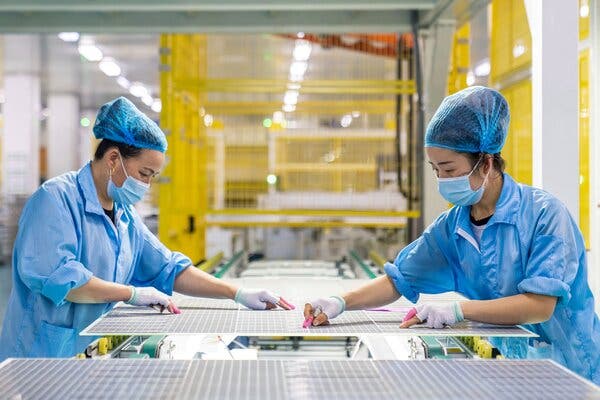WASHINGTON — President Biden announced Friday that he would extend tariffs on imported solar products first imposed during the Trump administration but reduce the scope of products affected by the levies, a decision aimed at balancing his goals for bolstering domestic manufacturing with speeding up the transition toward clean energy.
The decision will impose a tariff of between 14 percent and 15 percent for the next four years on imported crystalline silicon solar products that are used to convert sunlight to energy. But the Biden administration also moved to double the amount of solar cells that can come into the country without facing tariffs, and said it would begin talks with Canada and Mexico to export their products to the United States duty-free.
The administration also said it would exempt a certain type of two-sided panel, called bifacial panels, from the levies, saying that the move would help ensure that solar deployment in the United States “continues at the pace and scale needed to meet the President’s ambitious climate and clean energy targets.”
The carve outs will maintain some protection for domestic industry while also allowing solar energy projects to continue accessing some cheap foreign solar products. But they are also likely to anger some domestic manufacturers and the president’s allies in the labor movement, who argue that the administration should be doing more to shield American manufacturers from cheap Chinese products.
Mark Widmar, the chief executive of First Solar, a solar panel manufacturer in the United States that had fought for tougher restrictions on imported products, said he was “deeply disappointed” in the decision and that it would allow China “to outflank American efforts to grow self-reliant solar supply chains.”
“Today’s decision places at risk billions of dollars in existing investment, thousands of jobs, our country’s energy security and a climate-critical transition to net-zero emissions,” he added.
Companies that install solar power projects with foreign panels praised the decision to scale back the tariffs.
“Every dollar spent on tariffs means less dollars put towards creating jobs and opportunity in communities,” said George Hershman, the chief executive of SOLV Energy, the nation’s largest utility-scale solar installer. “The bifacial exclusion will help us greenlight projects and deploy more solar capacity across the country.”
The issue of how to treat imported solar products has divided some of the administration’s traditional allies. Labor unions, along with those who prioritize efforts to build a domestic solar industry and reduce trade with China, have pushed back against solar energy developers and others who see combating climate change as among the administration’s most important tasks.
Mr. Biden has pledged to cut U.S. emissions at least 52 percent below 2005 levels by the end of this decade, and the administration is counting on solar power to play a significant role in reducing emissions from electricity production. A recent Energy Department report found that solar energy could provide up to 40 percent of the nation’s electricity by 2035, compared with its current 4 percent.
But much of the world’s supply of solar panels comes from China, which has spent heavily on industrial subsidies to support its industry.
According to estimates by Wood MacKenzie, a consultancy business for global energy, China dominates all stages of the solar supply chain, producing between 60 and 80 percent of the world’s polysilicon, wafers, crystalline silicon cells and solar modules.
A White House statement said that the tariff decision was “a significant step forward in the President’s comprehensive effort to rebuild a strong North American solar supply chain that will help create good jobs, reduce our dependence on foreign suppliers, and meet the President’s ambitious clean energy and climate goals.”
“We’ve been consulting with all sectors of the solar industry, and they all agree that the Section 201 tariffs are not — on their own — going to bring back solar cell production or grow module production to a point where it can supply U.S. needs,” the statement said, referring to the provision of the Trade Act that allows the United States to impose tariffs.
In February 2018, former President Donald J. Trump followed the recommendation of the International Trade Commission, an independent panel that reviews trade cases, in imposing tariffs on crystalline silicon photovoltaic cells to help protect the domestic industry. The tariffs would start at 30 percent, and then decline by five percentage points each year over the course of four years.
Those tariffs were set to expire this month. But several manufacturers, including Auxin Solar, Suniva, Hanwha Q CELLS USA, LG Electronics and Mission Solar Energy, petitioned to extend the levies, arguing they were still needed to support the domestic industry.
In November, the members of the International Trade Commission recommended extending the tariffs, saying that the measures had helped domestic producers but that they continued “to be necessary to prevent or remedy serious injury to the U.S. industry.”
Lisa Friedman contributed reporting.


























